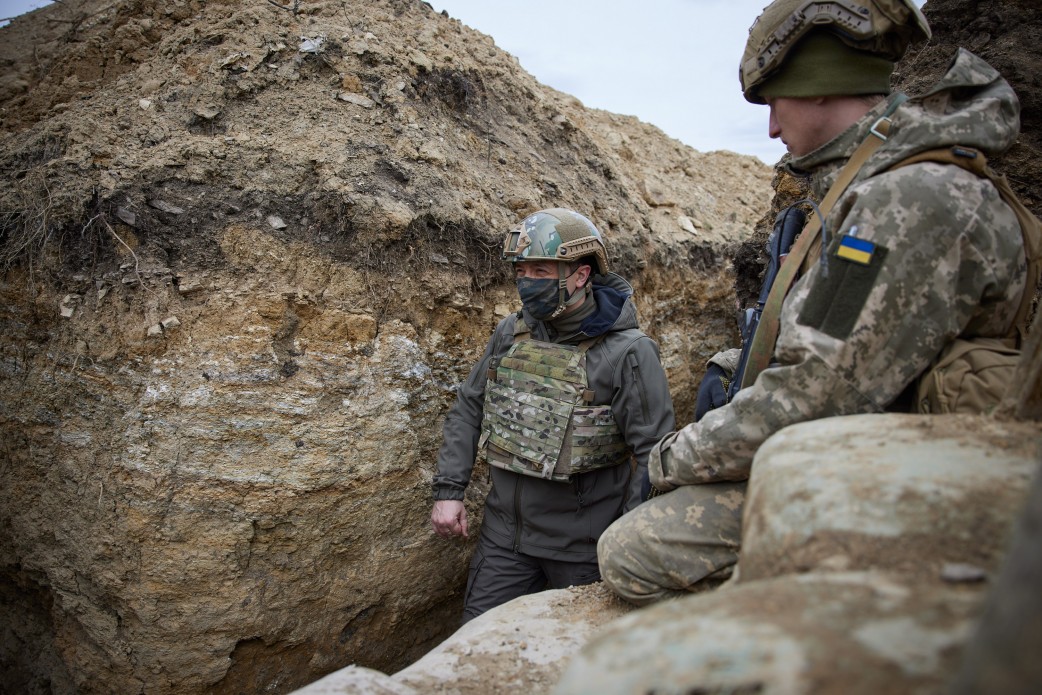Today Ukrainian President Volodymyr Zelensky paid a visit to the Kherson region, immediately north of Crimea, which his government refers to as temporarily-occupied territory. The development came less than three weeks after he visited the front line in the Donbass region, directly across from what the Ukrainian government calls Russian-occupation forces.

Zelensky at the Donbass front on April 8
In Kherson he was described as touring trenches and dugouts of troops assigned to the Joint Forces Operation (until three years ago the Anti-Terrorist Operation) which the nation of almost 45 million has deployed against the Donetsk and Lugansk republics with a combined population of under three million. He also visited a base camp.
At the same time Ukrainian government and pro-government press sources accused “Russian-occupation forces” of shelling government forces on the line of conflict three times.
The repeated use of the expression Russian-occupation forces leaves no doubt as to who the Ukrainian regime, along with its sponsors in the U.S., NATO and the European Union, is attempting to portray itself as engaged in armed conflict with.
To demonstrate that the recent withdrawal of Russian military personnel from Russia’s border with the Donbass and from Crimea – after the U.S., NATO and the EU backed Kiev’s demand they do so – would not diminish the accusations against Russia in any way and would not halt Ukrainian military preparations (and Western military assistance), Zelensky intoned:
If three weeks ago Zelensky, a former entertainer and television actor, portrayed a valiant president under fire of a nation under siege, today he struck the pose of the victor in a confrontation with a larger and mightier adversary.
Today the American embassy in Ukraine tweeted the following:
“The United States continues its unwavering support of the Armed Forces of Ukraine with $7.85M in command and control, communications, vehicle spare parts, medical components, & tactical equipment as part of the latest delivery of security assistance totaling over $2B since 2014.”
That $2 billion in military aid since the U.S.-orchestrated overthrow of the Ukrainian government to conduct war in the Donbass will be increased by an additional $300 million dollars approved by the Senate Foreign Relations Committee on April 21, which specifically includes lethal arms.
In March Washington also announced a $125 million tranche as part of its Ukraine Security Assistance Initiative established by the Pentagon last year.
It seems fairly indisputable that the Western client regime in Ukraine feels sufficiently emboldened by its American and European sponsors, and unequivocally backed by the military might of the thirty-nation NATO military bloc, to make the statements and engage in the activities it is.
Head of the Office of the President of Ukraine Andriy Yermak recently said the U.S. will get directly involved in the Donbass conflict with these words: “If we talk about concrete steps, the appointment of a U.S. special representative for the settlement and end of the war in Donbas is being actively discussed today. It is very important that such a person appears.”
Earlier this month the same official said in an interview: “Ukraine is holding the line against Russia, not just for us, but for the West. And where does the U.S. deploy its Patriot Missiles? The closest ones are in Poland. They should be here.”
And no doubt they will be. With an American special envoy for the Donbass dispute. And perhaps another $2 billion in military aid, more and more of it lethal. When the Western-backed regime of Volodymyr Zelensky speaks of temporarily-occupied areas they mean what they say. Unlike another player, or non-player if you like, in the conflict with its references to nebulous and one suspects non-existent red lines.
Rick Rozoff is a contributing editor at Antiwar.com. He has been involved in anti-war and anti-interventionist work in various capacities for forty years. He lives in Chicago, Illinois. He is the manager of Stop NATO. This originally appeared at Anti-Bellum.


